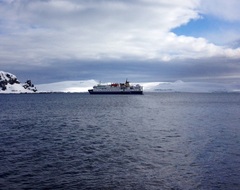 Seeking the Drake Seeking the Drake The Drake Passage, a 600 mile expanse spanning the Southern Ocean between Tierra del Fuego and Antarctica, is watery highway that has carried many explorers, scientists and tourists to the icy continent at the southernmost latitudes of the globe. Making way through this oceanic version of Hades, it is difficult to imagine what pushed the early explorers to prove the existence a place that once only existed in theory. My voyage was made in relative luxury compared to those who crossed in ancient wooden ships, without maps or GPS, in sea swells that towered over their trembling masts. While I wouldn’t trade ships with them, even if I could, I still envy their experience of uninhibited adventures, experiences that for the rest of us have been stripped by the conveniences of modernity. Like me, perhaps they suffer infection by the incurable affliction described as wanderlust. Yet despite the changing technology, for anyone who wishes to make acquaintance with the frozen continent, the Drake is still a rite of passage. Antarctica, labelled as Terra Australis Incognita or the unknown southern land on maps during the Age of Discovery in various imaginative forms, only became known to those who dared venture to sail through the Drake, some by accident and some with intent throughout the 19th century. Crossing the Drake in a modern vessel requires 2-4 days in the open high seas but for the explorers of auld lang syne, it required weeks of cold and miserable hardship in a vessel assailed by the mighty force of the Drake’s waters. Sailing due south today, Antarctica is clearly delineated on a map, making navigation to landing sites a relatively straightforward task. The original explorers set sail across the dread Drake, not even knowing land existed, sailing on expeditions fuelled by dreams and on the energy of the hope of discovery of new territory and resources.  Thanksgiving Day in the Drake Thanksgiving Day in the Drake The Drake is a fearsome thing. Experiencing a Beaufort 11 force storm, with waves cresting higher than my vantage point on the top floor of the Ocean Nova, I was awed by the power of the sea as it tossed our polar class ship from side to side, our able captain holding bow to the waves. Although never experiencing the storms of the Drake himself, Coleridge described it as tyrannous and strong. The poetic lines, while lyrically descriptive of the essence of the Drake, are insufficient to capture the experience of the passage. During this storm, I vacillated between comfort in knowing the sea around us was virtually empty as demonstrated by AIS data available onboard--and thus we were unlikely to be in an unwitting collision with another vessel, and also knowing that if an incident occurred, any help was too far away to be certain of salvation. Accompanying this to-ing and fro-ing of Drake storms is the near indescribable malaise experienced throughout the passage. Even if one does not succumb to the fullness of seasickness, the Drake drains all energy from the core of your being, leaving victims with black and hollow eyes. Many follow the practice of ‘dry Drake’, abstaining from alcohol to limit the effects of this strange sea-malady. It provided some consolation to learn one heroic explorer observed that the more intelligent a being, the more likely they were to succumb to the effects of the Drake --and I was exceedingly ill. Even many of those who boasted of many previous sea voyages without effect were influenced by its spell.  Ocean Nova in better waters Ocean Nova in better waters A benefit of exploration in modernity is the availability of drugs, substances intended to induce healing or to prevent suffering and never ever to be misused. There are some drugs that are better than others, and most have a drug of choice, including options such as caffeine and alcohol. But on the Drake, the drug of choice is merely anything that will help one to avoid seasickness—the harder the better. The first trip, I tried the softer antidotes for motion sickness, with the disastrous result of losing my breakfast during the delivery of a lecture on Antarctic history. The second voyage, I was prescribed the hard stuff by the ship’s doctor, resulting in the peaceful passage of the Drake in a near continuous bout of slumber. In the case of the Drake, drugs are always the answer. Passing through the Drake, with drugs or without them, gives the experience of two types of dreams. The first is of an exceeding malicious nature and is an embodiment of the essence of the Drake: the Drake introduces nightmares to one’s consciousness throughout the voyage. Mine included the horrors of the mass slaughter of orcas by bounty hunters, the black of their bodies prostrated against the sparkle of the Antarctic ice, stained with red from blood—a nightmare of the worse kind. The better dream that the Drake delivers is the realisation of a region so pristine and pure--a wilderness that envelops your being with enchantment and wonder. The Drake is certainly something to be survived, but when one does, the rewards are beyond any suffering experienced throughout its passage. And when one has finished the arduous journey, it is easy to see why some are compelled to repeat it again and again. *Thank you to Dr Sergio Pesutic for the comedic speech given before one passage of the Drake, introducing the conceptual combination of Drake+Drugs=Dreams. He was not wrong. #PolarRegions
1 Comment
|
AuthorCorine loves a good adventure. She's partial to wilderness, UNESCO World Heritage sites and wine. Based in the United Kingdom, she has roamed the trails and streets of six continents. This is a chronicle of her experiences, seasoned liberally with philosophical musings. Archives
June 2015
Categories
All
|
 RSS Feed
RSS Feed